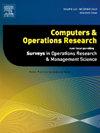具有可变子批的柔性作业车间调度问题的一种新的拓扑邻域结构
IF 4.1
2区 工程技术
Q2 COMPUTER SCIENCE, INTERDISCIPLINARY APPLICATIONS
引用次数: 0
摘要
批流是一种有效的方法,通过将每个操作分成子批来减少机器空闲时间,从而实现并行处理。然而,由于批处理和调度的可变性,搜索空间也将急剧扩大。邻域结构是在复杂搜索空间中以较少的计算量获得高质量解的有效方法。提出了一种新的邻域结构,并利用它开发了一种求解可变子批柔性作业车间调度问题的有效算法。首先,建立了一个三维析取图,通过加入一个批处理轴来清晰地表示解。这种表示捕获了全面的邻域特征,并为邻域扰动提供了稳健的基础。随后,提出了一种新的拓扑邻域结构进行更深入的探索,在保证邻域解质量的同时,有效避免了不可行解的产生。将新的拓扑邻域结构集成到可变邻域搜索组件中,进行有效的局部搜索。在此基础上,提出了一种拓扑引导模因算法(TGMA),该算法可以在复杂解空间中获得高质量的解。在不同尺度的扩展基准上组织了实验,在超过90%的实例中,所提出的TGMA可以获得比几种最先进算法更好的解决方案。结果表明,该方法在求解复杂的高维FJSP-VS问题时,在求解质量和计算效率方面表现出优异的性能。本文章由计算机程序翻译,如有差异,请以英文原文为准。
A novel topological neighborhood structure for flexible job shop scheduling problem with variable sublots
Lot streaming is an effective approach to reduce machine idle time by splitting each operation into sublots, enabling parallel processing. However, the search space will also expand dramatically due to the variability of batching and scheduling. Neighborhood structure is an effective approach to obtain high-quality solutions with less computational effort in a complex search space. This paper proposes a novel neighborhood structure, and uses it to develop an effective algorithm for flexible job shop scheduling problem with variable sublots (FJSP-VS). Firstly, a three-dimensional disjunctive graph is developed to represent solutions clearly by incorporating an axis of batching. This representation captures comprehensive neighborhood features, and provides a robust basis for neighborhood perturbations. Subsequently, a novel topological neighborhood structure is proposed for deeper exploration, which can effectively avoid the generation of infeasible solutions while ensuring the quality of neighborhood solutions. The novel topological neighborhood structure is integrated into a variable neighborhood search component, for effective local searching. On this basis, a topology-guided memetic algorithm (TGMA) is proposed, which can obtain high-quality solutions in the complex solution space. Experiments are organized on expanded benchmarks of varying scales, and the proposed TGMA can obtain better solutions than several state-of-the-art algorithms in over 90% instances. The results demonstrate its superior performance in solution quality and computational efficiency when solving the complex high-dimensional FJSP-VS.
求助全文
通过发布文献求助,成功后即可免费获取论文全文。
去求助
来源期刊

Computers & Operations Research
工程技术-工程:工业
CiteScore
8.60
自引率
8.70%
发文量
292
审稿时长
8.5 months
期刊介绍:
Operations research and computers meet in a large number of scientific fields, many of which are of vital current concern to our troubled society. These include, among others, ecology, transportation, safety, reliability, urban planning, economics, inventory control, investment strategy and logistics (including reverse logistics). Computers & Operations Research provides an international forum for the application of computers and operations research techniques to problems in these and related fields.
 求助内容:
求助内容: 应助结果提醒方式:
应助结果提醒方式:


